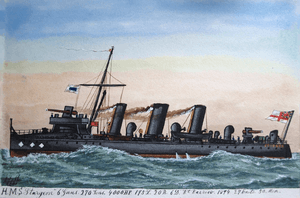Sturgeon-class destroyer
The Sturgeon-class destroyers served with the Royal Navy from 1894; three were built by the Vickers yard and differed from other similar ships in having their mast stepped before the first funnel. They had Blechynden boilers which gave them 4,000 hp (3,000 kW) and 27 knots (50 km/h; 31 mph). They were armed with one twelve pounder and two torpedo tubes. They carried a complement of 53 officers and men.
 A watercolour of Sturgeon c. 1901 | |
| Class overview | |
|---|---|
| Name: | Sturgeon class |
| Builders: | Vickers |
| Operators: |
|
| Preceded by: | Rocket class |
| Succeeded by: | Swordfish class |
| Built: | 1894–1895 |
| In commission: | 1894–1911 |
| Completed: | 3 |
| Scrapped: | 3 |
| General characteristics | |
| Type: | Torpedo boat destroyer |
| Propulsion: | Blechynden boilers, 4,000 hp (2,983 kW) |
| Speed: | 27 knots (50 km/h; 31 mph) |
| Complement: | 53 |
| Armament: |
|
Construction and design
On 8 November 1893, the British Admiralty placed an order with the Naval Construction and Armament Company of Barrow-in-Furness (later to become part of Vickers) for three "Twenty-Seven Knotter" destroyers as part of the 1893–1894 construction programme for the Royal Navy,[1] with in total, 36 destroyers being ordered from various shipbuilders for this programme.[2]
The Admiralty only laid down a series of broad requirements for the destroyers, leaving detailed design to the ships' builders. The requirements included a trial speed of 27 knots (31 mph; 50 km/h), a "turtleback" forecastle and a standard armament of a QF 12 pounder 12 cwt (3 in (76 mm) calibre) gun on a platform on the ship's conning tower (in practice the platform was also used as the ship's bridge), with a secondary armament of five 6-pounder guns, and two 18 inch (450 mm) torpedo tubes.[3][4][5]
The Naval Construction and Armament Company produced a design with a length of 194 feet 6 inches (59.28 m) overall and 190 feet (57.91 m) between perpendiculars, with a beam of 19 feet (5.79 m) and a draught of 7 feet 7 inches (2.31 m). Displacement was 300 long tons (300 t) light and 340 long tons (350 t) deep load.[1] Three funnels were fitted, with the foremast between the ship's bridge and the first funnel.[6][7] Four Blechyndnen water-tube boilers fed steam at 200 pounds per square inch (1,400 kPa) to two three-cylinder triple expansion steam engines rated at 4,000 indicated horsepower (3,000 kW).[1][8] 60 tons of coal were carried,[9] giving a range of 1,370 nautical miles (2,540 km; 1,580 mi) at a speed of 11 knots (20 km/h; 13 mph).[10] The ship's crew was 53 officers and men.[10]
Ships
References
Notes
- Lyon 2001, p. 69.
- Lyon 2001, p. 19.
- Lyon 2001, p. 20.
- Lyon 2001, pp. 98–99.
- Friedman 2009, p. 40.
- Friedman 2009, p. 50.
- Manning 1961, p. 38.
- The Engineer 11 October 1895, p. 365.
- Brassey 1902, p. 274.
- Friedman 2009, p. 291.
Bibliography
- Brassey, T.A. (1902). The Naval Annual 1902. Portsmouth, UK: J. Griffin and Co.
- Chesneau, Roger & Kolesnik, Eugene M., eds. (1979). Conway's All The World's Fighting Ships 1860–1905. London: Conway Maritime Press. ISBN 0-85177-133-5.
- Friedman, Norman (2009). British Destroyers: From Earliest Days to the Second World War. Barnsley, UK: Seaforth Publishing. ISBN 978-1-84832-049-9.
- Gardiner, Robert & Gray, Randal, eds. (1985). Conway's All The World's Fighting Ships 1906–1921. London: Conway Maritime Press. ISBN 0-85177-245-5.
- Layman, R. D. (1994). "Naval Kite Trials". In Roberts, John (ed.). Warship 1994. London: Conway Maritime Press. pp. 35–51. ISBN 0-85177-630-2.
- Lyon, David (2001) [1996]. The First Destroyers. London: Caxton Editions. ISBN 1-84067-3648.
- Manning, Captain T. D. (1961). The British Destroyer. Putnam and Co. OCLC 6470051.
- "Speed Trials of the Torpedo Boat Destroyer Starfish" (PDF). The Engineer. Vol. 80. 11 October 1895. p. 365.